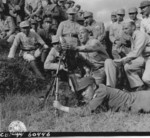M2 Mortar Launcher
| Country of Origin | United States |
| Type | Launcher |
| Caliber | 60.000 mm |
| Barrel Length | 726.000 mm |
| Weight | 19.050 kg |
| Ammunition Weight | 1.40 kg |
| Rate of Fire | 18 rounds/min |
| Range | 1.815 km |
| Muzzle Velocity | 158 m/s |
Contributor: C. Peter Chen
ww2dbaseThe 60-millimeter M2 mortar was of French origin, having been designed by French engineer Edgar Brandt. The US Army purchased a license for production in the late 1930s to bridge the gap between the heavier 81-millimeter M1 mortar and the hand grenade in contemporary use by the US Army. The first order for 1,500 examples was placed in Jan 1940. Each of these weapons was made of a smoothbore metal tube attached to a rectangular baseplate, supported by a bipod. To fire these weapons, each shell was dropped into the barrel, allowing the 20-gauge M5A1 ignition cartridge in the tail to make contact with the firing pin at the bottom of the barrel, detonating the cartridge and launching the shell. Unassisted, each shell could travel between about 200 and 300 yards (about 180 to 275 meters), but with up to bags of booster charges attached to the tail fins of a shell, an absolute maximum range of 2,000 yards (about 1,800 meters) could be achieved, depending on the type and weight of shell. Typical shells used were the M49A2/M49A3 high explosive, M302 white phosphorus, and M83 illumination types. Each weapon was typically operated by a crew of three (squad leader, gunner, and loader), support by a number of ammunition carriers. During WW2, they were in widespread use by ground forces of the US Army and the US Marine Corps. After WW2, they continued to see action with US forces in the Korean War and the Vietnam War. They were replaced by the M224 mortars, also of 60-millimeter caliber, in 1978.A number of US-friendly forces received M2 mortars, including China (later relocated to Taiwan), France (saw action in its colonies in Indochina and Algeria), Portugal (saw action in its colonies in Africa), South Vietnam (saw action in Vietnam War), and many others.
Communist China produced these weapons without license under the designation of Type 31, Type 63, and Type 63-1. A number of these weapons saw action in the Korean War and the Vietnam War under the banners of communist forces. The Type 63-1 design was later licensed for production by the Pakistan Machine Tool Factory Limited of Pakistan and the Helwan Machine Tools Company of Egypt.
Source: Wikipedia ww2dbase
Last Major Revision: Aug 2019
Photographs
 |
Please consider supporting us on Patreon. Even $1 per month will go a long way! Thank you. Please help us spread the word: Stay updated with WW2DB: |
Search WW2DB
News
- » US Women's Army Corps "Six Triple Eight" Awarded with Congressional Gold Medal (30 Apr 2025)
- » Wreck of Soviet Submarine M-49 Found (10 Apr 2025)
- » Japanese Emperor Visited Iwoto (Iwo Jima) (8 Apr 2025)
- » Race, Holocaust, and African-American WW2 Histories Removed from the US Naval Academy Library (7 Apr 2025)
- » US Government Plans to Purge WW2 Information (17 Mar 2025)
- » See all news
Current Site Statistics
- » 1,167 biographies
- » 337 events
- » 44,617 timeline entries
- » 1,244 ships
- » 350 aircraft models
- » 207 vehicle models
- » 376 weapon models
- » 123 historical documents
- » 261 facilities
- » 470 book reviews
- » 28,514 photos
- » 365 maps
Famous WW2 Quote
"With Germany arming at breakneck speed, England lost in a pacifist dream, France corrupt and torn by dissension, America remote and indifferent... do you not tremble for your children?"Winston Churchill, 1935
Support Us
Please consider supporting us on Patreon. Even $1 a month will go a long way. Thank you!
Or, please support us by purchasing some WW2DB merchandise at TeeSpring, Thank you!